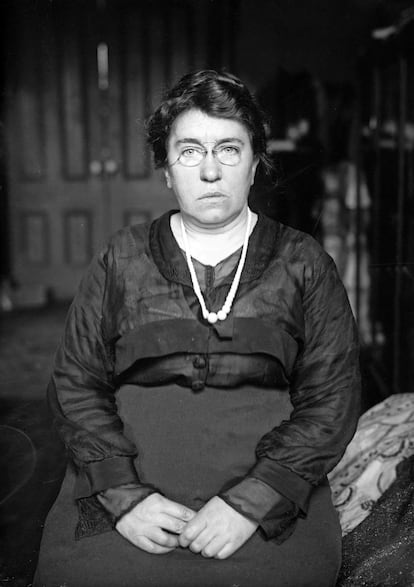Emma Goldman: The world’s most dangerous idealogue
The Lithuanian-born American anarchist is still lauded as an iconic feminist leader more than 80 years after her death

Emma Goldman would surely be amazed to see T-shirts and mugs bearing her likeness for sale on the internet. A popular paraphrase of her ideas – “If I can’t dance, I don’t want to be in your revolution” – has been reproduced on countless memes, stickers and posters, as has “I’d rather have roses on my table than diamonds on my neck.” And she would surely laugh to see her name near the top of “Philosophers ranked by their punk credentials,” far above eminent philosophers like Hobbes, Heidegger, Confucius, Burke and Kant.
But in all seriousness, Goldman’s place in contemporary iconography is as real as her influence on feminists as diverse as Virginie Despentes, bell hooks, Rosi Braidotti and Vivian Gornick. A recent flurry of new Spanish-language editions of Goldman’s writings show that her ideology is still relevant and even thriving.
What did this woman who was born more than 150 years ago in the Lithuanian city of Kaunas, and who emigrated to the United States as a teenager, do to deserve such attention? What she did was challenge age-old ideas about leaders and followers. “She rebelled, in word and deed, and in the way she lived and worked, against every kind of authority – paternal, family, religious, educational, governmental, legal and cultural authority,” said Ana Muiña, a historian and expert in social movements.
Goldman was a tireless rebel at a time when protesting the status quo could cost you dearly. She was an activist, thinker and agitator in cafés, city streets, factory floors and prison cells who spoke at countless demonstrations, conferences and debates about labor repression, the subjugation of women, nationalism, police and government political violence, and war, which she called, “the business of massacre.”
Eight thousand years ahead of her time
Goldman’s ideas were avant-garde and fueled by rage. She espoused a direct, participatory and horizontal form of democracy, fiercely defended freedom of speech and expression, and was one of the few people to speak out against the conviction for homosexuality of her friend, Oscar Wilde. She was so radical that even her mentor, Peter Kropotkin, the aristocratic Russian anarchist, thought she went too far. American journalist William M. Reedy came to her defense, saying she was simply “eight thousand years ahead of her time.”
Goldman lived at a time when a judge could condemn a group of Chicago workers to death for planting a bomb without any proof (May 1, 1886), and at a time when 146 women perished in a New York factory fire (March 8, 1911) – injustices that are commemorated to this day. It was also a time when police could fire into a crowd of 19 striking Pennsylvania miners in 1897. But when it came to self-defense, the anti-war Goldman never shied away from violence, perhaps because of the physical violence she endured as a child. Her autobiographical Living My Life vividly describes how her father would beat her in the head and her uncle would kick her down the stairs for being disobedient.
As a young woman, Goldman worked in textile factories and started her own home-based business sewing gloves. She worked as a midwife and witnessed the terrible living conditions of people in New York’s working-class neighborhoods, writing about their “inert and tedious submission to their fate.” She helped women living “in constant fear of conception” who screamed “barbarities” at God and their husbands during labor. “Get him out of here! Don’t let that beast get near me or I’ll kill him!” shouted one of her patients with eight children.
Goldman did that and more. She railed against the bondage of marriage, had many affairs and lovers, and refused to become dependent on any man. She liked to laugh, dance and drink, and violated a taboo of puritanical America by talking about a woman’s sexual pleasure. She was once jailed for disseminating information about contraceptive methods. Journalist Margaret Anderson wrote in The Little Review, “Goldman was sent to prison for saying that women shouldn’t have to always keep their mouths shut and wombs open.”
Her ideas “are still ferociously relevant because they touch every aspect of human emancipation,” Muiña told EL PAÍS. Goldman embodied the very contemporary notion that people “are intricate, unfinished tapestries that burst into color through our relationships with others,” said Laura Vicente, the author of a recent book on Goldman. She also believed that human beings could invent themselves, and should always strive “to change ideas and values, and to transform the basic relationships between humans, and between humans and society,” said Vicente.
Goldman lived out her activism and suffered the consequences. Goldman wrote, “I believe that militarism will cease when freedom-loving people all over the world say to their masters, ‘Go ahead and kill each other. We have already sacrificed ourselves and our loved ones enough to continue fighting your battles.’” In 1917, her protests against World War I got her arrested by J. Edgar Hoover – the future head of the FBI – who called Goldman “one of the most dangerous women in America” and had her deported even though she was a US citizen.
Goldman took the struggle everywhere she went, wrote Theresa and Albert Moritz in The World’s Most Dangerous Woman: A New Biography of Emma Goldman. When she was deported from the US, Goldman went with high hopes to post-revolution Russia. But after living for two years among the Bolsheviks and witnessing their brutal repression of the Russian people, she wrote a series of newspaper articles that were later collected and published in book form as My Disillusionment in Russia.
In the last years of her life, Goldman traveled the world giving lectures and speaking at rallies until she suffered a stroke in the winter of 1939 that left her unable to speak. She died at her home in Toronto (Canada) on May 14, 1940.










































